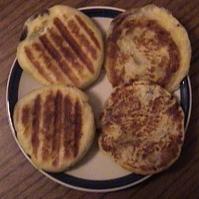Such a fiasco, indeed - after tasting the first bite of this experimental dish, I could honestly say that I knew it wasn't for me. The broth was tangy, the noodles were bland, the pear and cucumber combination was just wrong...and, truly, the cold soup was even too cold for me. Perhaps I hadn't given it a completely fair shake. I mean, I did kind of expect this to happen - so, you could assume that I had set the situation up for failure from the beginning. But, in fairness to the meal, I ate a few more bites to substantiate my feelings. Sure enough, it wasn't for me. Probably not for most Westerners. Perhaps not even for many Koreans. But, it was an interesting journey into a faraway land of food. And, as they say - you don't know about something unless you try it!
If anyone is curious enough to make this dish (despite how unappetizing I have made it sound), the recipe is as follows:
Ingredients:
One package of buckwheat noodles (get these from a Korean grocery store - ask for naeng myun - the list of ingredients may read "buckwheat noodles" or may include a few other ingredients like "sweet potato starch," "wheat," and "salt.")
One carton of organic chicken or organic beef broth
Sea salt
Vinegar (brown rice vinegar is best, white vinegar will do)
One cucumber, peeled, seeded with a spoon, then sliced into thin strips about 2 inches long
One Asian pear, peeled and thinly sliced
Soft boiled egg - one for each person
Instructions:
(Traditionally, the broth for mool naeng myun is made with about 1/3 beef broth, 1/3 chicken broth, and 1/3 kim chi brine. But because few people have easy access to all three components, most Koreans use just beef broth or chicken broth.)
- Pour organic chicken or beef broth into a large bowl. Add 2 tablespoons of vinegar, stir gently, and taste. Imagine drinking this broth while eating chewy buckwheat noodles and add more vinegar if you prefer more tang. This is the step that requires a previous encounter with well made mool naeng myun. Add a small amount of sea salt, to taste. If you have at least an hour before mealtime, put this bowl of broth in the refrigerator to chill.
- Put buckwheat noodles into a large pot of boiling water and cook for 3-4 minutes. They should be taken out as soon as they are al dente - chewy and not too soft. At this point, put noodles in a large colander and rinse two to three times with cold water. Allow noodles to rest in the colander for a few minutes or until excess water has been drained.
- To serve, place a large handful of noodles in a large eating bowl. Add a small bunch of cucumber strips, a few pear slices, and one soft boiled egg (cut in half right before serving) to the bowl. Then use a ladle to add a generous amount of cold and tangy broth to the bowl, enough to cover about 75 percent of the ingredients.
- Right before eating, feel free to use scissors to cut the noodles a few times to allow for more convenient mouthfuls.
- With each mouthful of noodles, vegetables, and egg, bring the bowl right up to your mouth and take a sip of the cold and tangy broth. Enjoy this traditional Korean summertime dish.
 (this picture is from original recipe page - mine looked similar to this, though I didn't have my camera handy)
(this picture is from original recipe page - mine looked similar to this, though I didn't have my camera handy)
